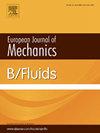Dispersion - erosion coupling in landslide
IF 2.5
3区 工程技术
Q2 MECHANICS
引用次数: 0
Abstract
Non-hydrostatic dispersive models can better describe the landslide motion. Following a dispersive wave equation and a mechanical erosion model for mass flows, here, we develop a novel dynamically coupled dispersion–erosion wave model that combines these two very essential complex processes. The newly developed model for landslide recovers the classical dispersive water waves and dispersive wave equation for landslide as special cases. We present several exact analytical solutions for the coupled dispersion–erosion model. These solutions are constructed for the time and spatial evolution of the flow depth. Solutions reveal that the dispersion and erosion are strongly coupled as they synchronously control the landslide dynamics. The results show that the wave dispersive wave amplifies with the increasing particle concentration, decreasing earth pressure, higher gravitational acceleration, increased slope angle and increased basal friction. The important novel understanding is that the intensity of the dispersive wave increases when erosion and dispersion are coupled. The results indicate the essence of proper selection of the initial and boundary conditions while solving applied and engineering problems associated with the dispersive - erosive mass transport. This provides the foundation for our understanding of the complex dispersion and erosion processes and their interplay.
滑坡中的分散-侵蚀耦合
非静力色散模型能较好地描述滑坡运动。继色散波动方程和质量流的机械侵蚀模型之后,我们开发了一个新的动态耦合色散-侵蚀波动模型,将这两个非常重要的复杂过程结合在一起。新建立的滑坡模型作为特例恢复了经典的色散水波和滑坡色散波动方程。本文给出了分散-侵蚀耦合模型的几个精确解析解。这些解是根据流深的时间和空间演变构造的。解表明,分散和侵蚀是强耦合的,因为它们同步控制着滑坡动力学。结果表明:随着颗粒浓度的增大、土压力的减小、重力加速度的增大、坡角的增大和基面摩擦力的增大,波的色散波增大;重要的新认识是,当侵蚀和色散耦合时,色散波的强度增加。结果表明,在解决与色散-侵蚀质量输运有关的实际问题和工程问题时,合理选择初始条件和边界条件是至关重要的。这为我们理解复杂的分散和侵蚀过程及其相互作用提供了基础。
本文章由计算机程序翻译,如有差异,请以英文原文为准。
求助全文
约1分钟内获得全文
求助全文
来源期刊
CiteScore
5.90
自引率
3.80%
发文量
127
审稿时长
58 days
期刊介绍:
The European Journal of Mechanics - B/Fluids publishes papers in all fields of fluid mechanics. Although investigations in well-established areas are within the scope of the journal, recent developments and innovative ideas are particularly welcome. Theoretical, computational and experimental papers are equally welcome. Mathematical methods, be they deterministic or stochastic, analytical or numerical, will be accepted provided they serve to clarify some identifiable problems in fluid mechanics, and provided the significance of results is explained. Similarly, experimental papers must add physical insight in to the understanding of fluid mechanics.

 求助内容:
求助内容: 应助结果提醒方式:
应助结果提醒方式:


